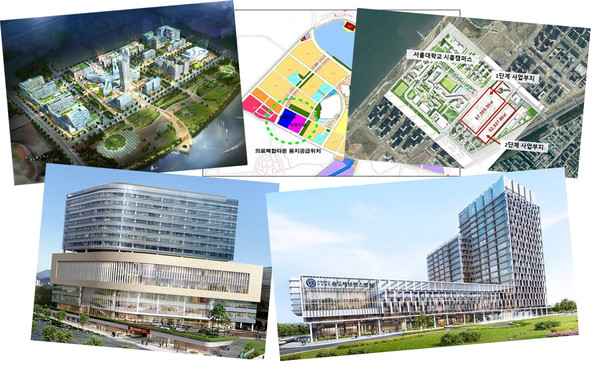University hospitals are fiercely competing to establish branches in the greater Seoul area, despite the medical community’s concerns over excessive competition.
Eight university hospitals have already decided to build branches in the Seoul capital area. Each branch hospital is expected to accommodate 500 to 800 beds. If all the eight hospitals add branches, the number of hospital beds will increase in greater Seoul by over 5,000.

Ajou University Hospital plans to put a branch in Pyeongtaek, Gyeonggi Province. On Wednesday, the Pyeongtaek City announced that it selected Ajou University Hospital-Together Holdings consortium as the preferred bidder for operation in the medical town within Pyeongtaek’s Brain City General Industrial Complex. Ajou University Hospital said its branch would have over 500 beds and open in 2027.
Inha University Hospital, which used to compete against Asan Medical Center in the bidding for operation in the Incheon Cheongna Medical Complex Town, decided to set up a branch in Gimpo, Gyeonggi Province. On July 30, Inha University Hospital and Inha University agreed with Gimpo City, Gimpo Urban Management Corporation, and Pungmu Development AMC to create “Gimpo Medical Campus.” The hospital plans to build a 700-bed branch in the Gimpo medical campus in 2024.
After receiving the highest score among five university hospitals, Asan Medical Center (AMC) was designated as the preferred bidder for business operation in the Cheongna Medical Complex Town. AMC said its branch in the Cheongna International City would accommodate 800 beds. It would spend 350 billion won ($306.1 million) on the branch establishment.
Other university hospitals, which were faster to decide on a branch, are speeding up their projects.
The Seoul National University Hospital (SNUH) constructs “Baegot Seoul National University Hospital” with 800 beds in Siheung, Gyeonggi Province. The plan already passed the preliminary feasibility test by the Ministry of Economy and Finance, and the SNUH will start the construction in 2022. It plans to complete the building in 2026 and open in late 2026 or the first half of 2027.
Yonsei University Health System (YUHS) plans to build “Songdo Severance Hospital” with 800 beds in Songdo, Incheon. The branch hospital with three basement floors and 14 stories above the ground will be built on Yonsei University’s International Campus.
YUHS held a groundbreaking ceremony in February and plans to open the branch in December 2026.
Chung-Ang University Hospital also plans to establish a 700-bed branch in Gwangmyeong, Gyeonggi Province, and open it as early as March next year.
Kyung Hee University Medical Center formed a consortium with Hanwha E&C to establish a 500-bed branch in Hanam, Gyeonggi Province.
Hanyang University Medical Center is also pushing to have a branch in Ansan, Gyeonggi Province.
Eulji University Hospital opened a 902-bed Uijeongbu Eulji Medical Center in Uijeongbu, Gyeonggi Province, in March.
Hospital beds increased 7.1% in greater Seoul in 5 years
Adding branches of university hospitals is likely to exacerbate the overcrowding of healthcare resources in greater Seoul. In 2019, 36 percent of all hospital beds in Korea were concentrated in the Seoul capital area.
Hospital beds in greater Seoul went up 7.1 percent from 237,391 in 2015 to 255,438 in 2019. The growth rate was faster than the 4.3 percent increase of all hospital beds in Korea. The proportion of beds in broader Seoul also climbed from 35.2 percent to 36.2 percent during the cited period.
The medical community raised concerns over the excessive competition for branch hospital establishment.
On Wednesday, Korea Community Hospital Association stated that the expansion of university hospitals would devastate the medical system in the long term.
“The attraction of a university hospital is up to the local government’s authority, but it would be impossible in the first place if there weren’t any support from the government,” KCHA said.
The government has claimed that the number of hospital beds needs to be reduced. Still, university hospitals are adding thousands of beds now, the group of regional hospitals said.
Roemer's Law – that a hospital bed built is a filled bed -- holds especially among university hospitals in Korea, and newly added beds in university hospitals will raise the demand for healthcare, KCHA said.
The expansion of university hospitals requires a lot of workforces, not only in nurses and medical technicians but physicians, the association went on to say.
The medical industry is manpower-intensive, but its concentration in the Seoul metropolitan area was accelerating, worsening the shortage of doctors in rural areas.
The Korean Medical Association also noted on July 23 that a reckless increase of hospital beds in certain regions could cause many problems and threaten the medical delivery system.
“The government should not just sit idle and do nothing about it,” the KMA said.

